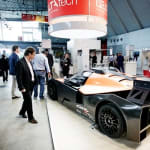 Lightweight construction represents one of the greatest opportunities and prospective growth areas for the fibre composites industry. Demand in Europe is on the rise, and the sector is looking to the future with optimism – especially in Germany, a hub of innovation with above-average increases in the production of lightweight materials. The positive mood was reflected as well at the 10th Composites Europe, where the anniversary event from 22 to 24 September 2015 set new records all around – in terms of exhibitors, visitors and exhibition space.
Lightweight construction represents one of the greatest opportunities and prospective growth areas for the fibre composites industry. Demand in Europe is on the rise, and the sector is looking to the future with optimism – especially in Germany, a hub of innovation with above-average increases in the production of lightweight materials. The positive mood was reflected as well at the 10th Composites Europe, where the anniversary event from 22 to 24 September 2015 set new records all around – in terms of exhibitors, visitors and exhibition space. The trade fair for fibre-reinforced plastics has been on an uninterrupted growth path ever since the event first took place. Composites Europe 2006 kicked things off with 168 exhibitors. When the event cycled back to Stuttgart this year for the tenth anniversary, 470 companies (prior Stuttgart event in 2013: 405) from 29 nations exhibited and filled three exhibition halls for the first time. With 10,087 visitors in attendance (2013: 9,171), Composites Europe set yet another record.
Drawn to the Exhibition Centre in Stuttgart above all were lightweight construction experts from the automotive sector, aerospace, mechanical engineering, the sports and leisure industry, wind power, and the construction sector.
What's more, Composites Europe has long been known as an important gathering place for the international industry: nearly half of all trade fair visitors (45%) came from outside Germany, with one in eight (13%) hailing from overseas. "Over the last ten years, Composites Europe has built an inclusive cross-sectoral network, which today benefits the entire composites industry. In this function, it is one of the most important international relationship brokers today", says Hans-Joachim Erbel, CEO of Reed Exhibitions Deutschland GmbH, the organiser of Composites Europe.
Composites market continues to grow in 2015
Glass-fibre reinforced plastics (GFRP) make up the composites industry’s largest group of materials by far, with a share of over 95% of the total volume. GFRP production is on track to grow by 2.5% in 2015, reaching the highest level in eight years with an estimated 1.069 million tonnes. That's the finding of the current market report issued by the German reinforced-plastics industry association AVK, which was presented in Stuttgart. Thermoplastic materials such as GMT and LFT are posting above-average growth rates. In addition to developing new products, researchers are focussed on multi-material composites systems in structural components. "The development of multi-material systems beyond individual materials groups remains one of the biggest challenges for the composites industry", says Dr. Elmar Witten, the managing director of AVK. Thorsten Kühmann, the managing director for plastics and rubber machinery at the VDMA’s Forum Composite Technology, underscores that assessment: "Lightweight and smart – modern components for user industries must be both. Composites Europe is very well positioned in this area today."Germany still top growth market
The highest growth rates are being posted by the composites industry in Germany: the largest market for fibre-reinforced plastics in Europe is set to grow by 6% in 2015, followed by the Eastern European countries (4%) and UK/Ireland (3%). The main purchasers continue to be the transport and construction sectors, followed by the electrical/electronics industry, and the sports and leisure industry.Trade fair visitors are also confirming the excellent economic prospects enjoyed by fibre-reinforced composites: 72% of respondents expect their respective sectors to experience upward economic momentum in the next three to four years. Only 18% forecast their industry to stagnate.




